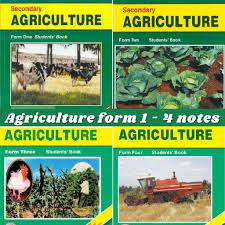SOIL FERTILITY I
This is the ability of the soil to produce and maintain high yields of crops for an indefinite period.
Characteristics of fertile soil
- Should have good depth
- Be well drained not water logged
- Well aerated
- Good water holding capacity
- Supply nutrients needed by plants in correct amount and form available to plants
- Correct soil pH for different crops
- Free from crop pests and diseases
How soil loses fertility
- Continuous growing of arable crops: continuous cultivation makes the soil loose and liable to erosion, this leads to lose of fertility.
- Mono cropping: growing of crops every season leads to depletion of soil nutrients
- Soil erosion: This leads to lose of top fertile soil
- Leaching: leads to lose of soil nutrients into the lower horizons of the profile
- Poor soil aeration: if soil is poorly aerated, the denitrifying bacteria increase in number and they make the infertile by converting nitrates into free nitrogen.
- Poor drainage of the soil: If the soil is poorly drained, the soil becomes flooded, forms acid soils which are useless for cultivation
- Dry soils: If the soils are dry, the nutrients cannot be dissolved to be used by crops
- Change of pH: soil pH influences the availability of certain nutrients e.g. low pH decreases solubility of phosphorus and high pH also decreases the availability of K, Mn etc
- Accumulation of salts: certain salts usually become toxic if present in excess e.g. Mn, boron, fluorine etc
- Burning of land: burning of land kills certain micro organisms and destroys certain nutrients
Ways of maintaining soil fertility
- Control of soil erosion: control of erosion prevents loss of top fertile soil
- Crop rotation: this ensures maximum utilization of crop nutrients. Also helps to control pest and diseases, it will also add nutrients if legumes are included in the rotation
- Maintaining soil pH: when soil pH is maintained at given ranges, particular nutrients will be available in the soils
- Proper drainage: soil should be well drained to eliminate flooding
- Weed control: control of weeds ensures no competition for nutrients, adequate space for crops and destroys alternate hosts for crop pests and diseases.
- Minimum tillage: this helps to maintain soil structure and prevent erosion
- Use of manures: manures supply a wide range of plant nutrients to the soil
- Use of inorganic fertilizers: inorganic fertilizers supply specific plant nutrients
Organic matter, humus, and manures
Organic matter: this is the remains of dead plants and animals and their waste products
Humus: humus is the decayed organic matter ie the remains of plants and animals which have decomposed
Roles of organic matter in the soil
- Increases water holding capacity and also water infiltration due to its colloidal nature
- Releases a wide range of nutrients into the soil thus improves fertility
- Provides food and shelter to micro organisms
- Improves soil structure by binding soil particles
- Buffers soil pH by avoiding rapid chemical changes due to the addition of lime and fertilizers
- Reduces toxicity of plants poisons that have built up on the soil as a result of continuous use of pesticides and fungicides
Manure: manures are organic substances that are added to the soil to provide one or more plants nutrients. They have high organic matter content
Classification of manures
Manures are classified according to: method of preparation and materials from which they are prepared.
Types of manures:
- Farmyard manure
- Compost manure
- Green manure
Download more free unlimited Agriculture Resources Here:
AGRICULTURE SCHEMES OF WORK FORM ONE TO FOUR: UPDATED
Agriculture notes free pdf download (Form 1-4)
AGRICULTURE REVISION QUESTIONS AND ANSWERS F1-4
Agriculture KCSE Topical Questions and Answers Form 1-4 (All subjects)
FORM ONE FREE AGRICULTURE NOTES
AGRICULTURE KCSE REVISION BOOKLET: F1-4 QUESTIONS (EXAMS) AND ANSWERS

- Farmyard manure
Farmyard manure is a mixture of animal waste (urine and dung) and crop residues used as animal beddings.
Importance of farmyard manure
- Increases yield of the crop
- Adds organic matter into the soil and improves the texture and water holding capacity of thee soil
- Adds useful bacteria to the soil
Factors influencing the quality of FYM
- Type of animals: dung from fattening animals is richer in nutrients than dairy farm animals which extract a lot of phosphorus from food eaten
- Type of food eaten: the richer the food in terms of minerals the richer will be the manure
- Type of litter / bedding material used: wood shavings and saw dust are slow to decompose and contain no nutrients and absorb 1.5 times as much urine as their weight, while Napier grass provide both N and P, but has low absorptive capacity. leguminous materials decompose faster
- Method of storage: farmyard manure must be stored well in a place with a cemented floor and covered roof. The N and P are soluble and therefore can get leached by heavy rains and N volatilizes if not covered
- Age of FYM: well rotten manure is richer in nutrients and easier to handle and mix with the soil than manure that is not fully rotten
- Species of animal from which the manure is collected. Non ruminants wastes richer in nutrients than ruminants
Preparation of farmyard manure
- A bedding of grass, wood shavings or saw dust is provided in the house of farm animals e.g. cattle, sheep
- The animals deposit their droppings and urine on the bedding materials
- After some time, i.e. daily, months or more as in poultry, the beddings are replaced with new ones
- The discarded beddings are deposited in a specially prepared shaded place
- New layers of used beddings are continuous added until a heap is formed
- N/B: decomposition and mineralization of the materials take place through activities of certain bacteria resulting in a rich manure
- Green manure
This is a type of manure prepared from green plants. The plants are grown for the purpose of incorporating into the soil when it’s green at the flowering stage for the purpose of improving soil fertility.
Characteristics of plants used for green manure
- They should be highly vegetative or leafy
- They should have faster growth rate
- They should have high nitrogen content, thus preferably legumes
- The plants must be capable of rotting quickly
- The plants should be hardy i.e. can establish in poor conditions
Reasons why green manure is not commonly used
- if food crops are used it’s hard for people to use them as green manure
- Green manure crops might use most of the soil moisture and leave very little for next main crop
- Most of the nutrients are used up by micro organisms in the process of decomposing the green manure plant. These will only be released by micro organisms when they die.
- It takes time for green manure crop to decompose and therefore planting is delayed
Preparation of green manure
- The plant to be used is planted in the field
- The plant is allowed to grow up to flowering stage
- Its then incorporated into the soil by ploughing
- Left to decompose after which the field is prepared for planting the main crop
- Compost manure
Compost manure is the accumulation of plants residue, mixed with animal waste, piled together in a heap where conditions are conducive for decomposition, sometimes contain refuse and kitchen left over foods
Preparation of compost manure
There are two methods namely:
- Indore / pit method
- Heap system (stack method)
- Indore / pit method
This was devised in a place called Indore in India
Procedure
- Dig 5 holes measuring 1.2m long, 1.2m wide and 1.2m deep.
- Assemble all the required materials near the pits.
- Start filling pit one to four with fibrous materials such as maize stalks which form the foundation of the compost layers.
- Followed with a layer of fresh materials to be decomposed e.g. grass, leaves to form the second layer.
- Add a layer of well rotten manure to provide nutrients to the micro- organisms used to decompose the organic materials.
- Add a thin layer of ash to improve the level of phosphorus and potassium in the resulting manure.
- Add a layer of top soil to introduce the micro- organisms required to decompose the organic matter.
- Repeat the above sequence until the whole pit is to full. /1.2m high.
- Add a layer of soil to cover the pits.
- After 3-4 weeks transfer the materials in pit IV to V, III to IV, II to III and I to II.
- Finally cover with grass or leaf layer to prevent loss of moisture
- Put a stick into the compost to check for the temperature to asses full decomposition
- Heap should be sprinkled with water after three days to control the temperature
- Manure will be ready for use in about 6 weeks time
N/B: Nitrogenous fertilizers are not added because they are easily leached
- The Heap system /stack method
- a) 4-heap
- b) 7 heap
To the field
- In this method, 4 heaps are used.
- Materials used are crop residue, animal waste old manure FYM or inorganic fertilizers and top soil.
- The materials is placed in heap X, and then transferred to heap Y after 3 – 4 wks. After another 3 – 4 wks, the compost is taken to heap Z where it stays for another 3 – 4 wks then taken to the field
N/B: The manure heaps must be turned occasionally at least every 3 months to facilitate circulation within the heap, manure should be ready after 6 months.
Cross section through a compost heap
- N/B: too much water cause water logging to the compost /leaching
- Too little water stop the bacterial action
- Always keep the compost under cover of grass and soil
- Posts are fixed at a distance of 1.2 m a part to form the 4 corners of the heap, the post should be 2m high
Factors to consider when selecting a site for compost manure
- Drainage of the site
- Direction of prevailing wind
- Size of the farm i.e. centrally placed
- Accessibility
Problems associated with organic manures
- Bulkiness
- Laborious in application and transport
- They spread diseases, pests and weeds
- Lose nutrients when poorly stored e.g. through leaching
- If not fully decomposed, crops will not benefit since it releases nutrients which can scotch the crops






